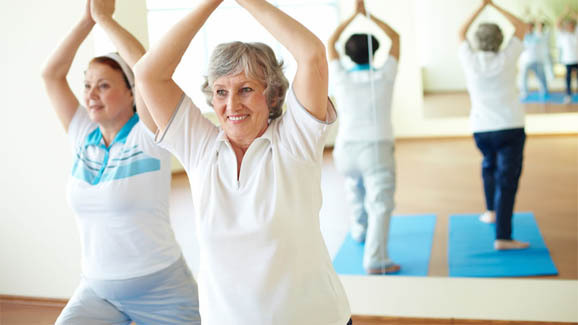More and more people in the world are ill with diabetes. This disease is incurable and requires careful treatment. A person with such a disease is forced to adhere to a certain diet and regime all his life.
But with diabetes, the benefit will also be physical activity. Small loads every day are very useful for a person with such a disease.
Pros

Physical education in diabetes of any type has many positive aspects. For example:
- In any sports classes, the sensitivity of the body to insulin increases.
- The level of glucose in the blood comes back to normal. In addition, the quality of the blood itself improves.
- There is a development of muscle mass.
- Weight decreases, and this is especially important in this disease.
- The nervous tension decreases, it undergoes stress.
- Vessels and heart are strengthened.
However, before you start physical education, it is worth to consult with your doctor, and maybe jointly develop a set of exercises.
In addition, physical exercise with diabetes mellitus has a slightly different effect on people with different types of this disease.
Sports load in type 1 diabetes.
Type 1 diabetes mellitus is insulin-dependent. People with this kind of disease are forced to inject insulin into the body throughout life. In addition, they often suffer from changes in blood glucose levels. Such jumps have a very negative impact on the patient - it is constantly accompanied by fatigue and prolonged stress. Of course, in this state, a person absolutely does not want to play sports .And the way of life without movement negatively affects the weakened organism. Sharp changes in blood sugar levels can lead to the occurrence of ketoacidosis or even coma. But exercise therapy for diabetes mellitus only benefits people with type 1 diabetes. However, a set of necessary exercises should be developed in conjunction with a specialist. At the same time, there is absolutely no need for a great deal of work, it is enough to engage in a little, but every day.
Studies have shown that Type 1 diabetics who exercise are much more careful to monitor their diet and blood sugar levels, they are less likely to develop dementia in their seniors and complications from this disease.
LFK in diabetes mellitus type 2
Type 2 diabetes mellitus is non-insulin-dependent. The main reason for the development of this type of disease is the poor sensitivity of tissues to insulin. Gymnastics in diabetes helps to fix this. The most important thing to do is constantly, every day, and not once from time.
If a person with type 2 diabetes will exercise regularly, he can achieve good results. Here they are:
- blood sugar level is normalized;
- the weight of a person decreases;
- thus constant physical exercises will help diabetics to keep in the norm the weight constantly;
- waist size will also decrease;
- will reduce the amount of cholesterol in the blood, and this will have an excellent effect on the vessels;
- will work your heart.
Very often in type 2 diabetes, patients are prescribed insulin injections. However, for the most part this happens with lazy people leading a sedentary lifestyle. Even the simplest gymnastics in diabetes mellitus improves the perception of tissues to the insulin produced. Therefore, with this form of illness physical exercises will be of great benefit. Moreover, it is possible to cancel insulin injections while improving health as a result of playing sports.
Features of

Despite the tremendous benefits of sports for diabetics 1 and 2, it is worth remembering certain rules so as not to harm the body. Here they are:
- Do not start immediately with very intense loads. To begin with, you need to choose more simple exercises. The fact is that heavy loads can lead to sharp jumps in the blood sugar level of the patient, and this is fraught with more serious problems.
- Conversely, intensive loads can not be abruptly terminated by the .Otherwise, hyperglycemia( elevated blood sugar levels) may develop, which will be difficult to control.
- You have to exercise every day and preferably at the same time. As a result, the effectiveness will be higher than in case of non-regular classes.
- Before starting a sport, consult your doctor. During physical education it is necessary to monitor the blood sugar level, so that if necessary, the doctor could adjust the treatment with medications.
- If a person chooses to use exercise therapy for diabetes, then he needs to adjust his diet. In addition, the intake of medications also need to be kept under constant control.
Observing these rules when practicing sports, you can provide tremendous support to your body.
What to choose
For people suffering from diabetes, aerobic work is best suited. They do not need frequent breathing and intense muscle contractions. Thanks to such exercises, the blood glucose level decreases, weight and fatty deposits decrease. And this, above all, is necessary for patients with diabetes mellitus. There are many different aerobic loads that are quite suitable for diabetics. These include:
- Walking, walking. At the same time, you do not need to strain heavily and carry weights. The pace should be calm.
- Jogging. Slow enough to keep your breath off.
- Calm swimming, not on time or competition. In addition, calm gymnastics in the water will also give excellent results.
- Roller skating, skating, skiing, biking. All this is allowed, provided that breathing does not increase.
- Dancing, except for too active, for example, rock'n'roll.
As you can see there is enough variety of sports that can bring not only benefits, but also fun for people with diabetes.
What can not be
Of course, as with any other disease, there are certain prohibitions that you also need to know. So, for example:
- it is impossible to engage in physical education if the sugar level exceeds 13-16 mM / l;
- or vice versa, if the glucose level is below 4.5 mM / l;
- it is impossible to run to marathon distances;
- in case of diabetic foot syndrome and persistent pain in calves;
- intensive loads are contraindicated in case of problems with vision;
- if urine contains a large amount of acetone;
- should not engage in traumatic sports.
Complex of exercises

Any complex of exercises for people with diabetes should be developed in conjunction with the doctor in charge. Exercises included in it, should give only a positive effect. Most often it includes the following:
- Walking. The exercise is done on site. You need to take turns to raise your knees, as if a person is walking. In addition, you can make attacks on the side. At the same time, you should try to do everything at a calm pace, so as not to break your breath.
- Squats. They are performed as follows: When you inhale, make an arch forward and stretch your arms straight. When you exhale, the arc is made down and squatting is performed.
- Turns with inclines. Perform as follows: make a tilt with a turn to the left, while the right hand should be straightened to the chest. Then repeat in the other direction.
- Tilting forward. Tilted forward, with the right hand touching the toe of the left foot. Then the same in the other direction.
These are some of the exercises that can be part of a sports complex for diabetics. Together with the attending physician, you can come up with others who will give a positive result.
Hypoglycemia
Active sports and emerging diabetes require careful attention to the occurrence of hypoglycemia. The fact is that with exercise, the sugar level can drop dramatically. Therefore, it is necessary to remember some rules. Here they are:
- The sugar level should be measured before and after the end of the session. If the level is higher than 10mM / l, then you do not need to take additional carbohydrates, and if below 10mM / l - then every half hour you need to take 1 unit of bread.
- In classes, fast carbohydrates must always be with you, so that if necessary, you can quickly raise the blood glucose level.
- Measure the sugar level every 30 minutes.
- You must have water with you.
These rules must be known to avoid negative consequences during physical education.
Do not think that sport and any type of diabetes are incompatible. On the contrary, correctly and moderately performed physical exercises can only benefit a person with such a serious illness.



